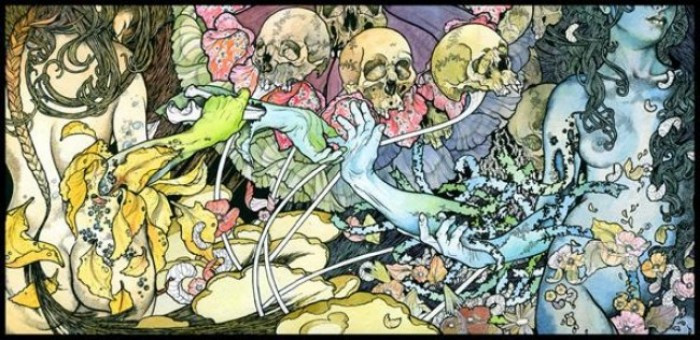A couple days ago we put up a post called “Slow, Then Fast”, the focus of which was a temporal experiment that our fellow metal bloggers at Death Metal Babboon conducted with a piece of doomy sludge (or sludgy doom) by a UK band called Blut. DMB honcho Niek took a cut from one of Blut’s very loooooong songs and sped it up by a factor of three, and reported on the results. We, in turn, put those same two tracks up on our site in order to share the interesting outcome of Niek’s experiment.
This gave us ideas. Because we do most things ass-backwards, we thought it would be interesting to flip Niek’s experiment around. We wanted to take a really fast song — a nice piece of balls-to-the-wall grindcore — and slow it down by a factor of three.
The original plan was to do this with a purely instrumental track, because we thought the slowing down of the music might make the vocals sound fucked up. But after reading the comments on that “Slow, Then Fast” post, we decided to use a track with vocals in addition to one without.
So that’s what we did. We used the same audio-editing software that Niek used, and we applied its magical tools to two songs: “Cemetery Road” by Pig Destroyer and an instrumental track called “Scepters” by Behold the Arctopus. The results surprised the hell out of us. Hear what happened . . . after the jump.
PIG DESTROYER
 Pig Destroyer is an awesome band, and an unusual group of individuals. If you’ve got more time to burn after you finish this post, you oughta read the feature on Pig Destroyer and the grind scene that was published, of all places, in The Washington Post’s Sunday magazine last year.
Pig Destroyer is an awesome band, and an unusual group of individuals. If you’ve got more time to burn after you finish this post, you oughta read the feature on Pig Destroyer and the grind scene that was published, of all places, in The Washington Post’s Sunday magazine last year.
It’s fascinating to read a non-metalhead reporter’s peak inside the world of a band like Pig Destroyer, trying to describe the experience for the kind of people who read The Washington Post (i.e., people unlike you and me) (“As the band ripped into the first song, I had the sensation of standing under a bridge as it was being torn apart.”) It’s long, but worth reading through to the very end. You can check it out here.
Now, onward with our experiment. We chose a Pig Destroyer song called “Cemetery Road” from the band’s Phantom Limb album (and therefore used the beautiful fold-out cover art by John Dyer Baizley at the top of this post). We picked “Cemetary Road” because it’s only 51 seconds long and because it’s really fast. Here’s what it sounds like as Pig Destroyer intended it to sound:
We first slowed down “Cemetery Road” until it lasted about 2 1/2 minutes. What’s amazing is that although we slowed the song to make it last three times as long, it still sounds fast, and it’s just as crazy as the original. Even the vocals still sound like vocals, almost as if they hadn’t been electronically altered. This is a sign of just how fast Pig Destroyer is playing in the original. Check it out:
After we listened to that 3x version of the song and realized how fast it still sounded, we decided to really slow it down. We slowed it to the point where the length of the song reached about 9 1/2 minutes — more than 10 times slower than the original.
This time, the result is frightening. It sounds like the gates of Hell have been flung open and a horde of demons are shambling out, shrieking and groaning in agony or anger. The guitar and bass groan and throb, the snare shimmers almost ceaselessly, and the bass drum sounds ridiculously ominous. You may not make it to the end, but try to hang in there for the first 3 minutes or so.
BEHOLD THE ARCTOPUS
 We next turned to Behold the Arctopus. They’re not really a grind band. They play an intensely technical and experimental form of prog that’s often mind-blowing to hear. But some of their music is extremely fast and just as bat-shit crazy as a lot of grind, so this seemed like fertile instrumental ground for our experiment.
We next turned to Behold the Arctopus. They’re not really a grind band. They play an intensely technical and experimental form of prog that’s often mind-blowing to hear. But some of their music is extremely fast and just as bat-shit crazy as a lot of grind, so this seemed like fertile instrumental ground for our experiment.
We picked the song “Scepters” off the band’s 2007 Skullgrid album. When that album was recorded, Behold the Arctopus consisted of Colin Marston (Krallice) on the Warr guitar (a 12-string monster that covers the range of a bass and a guitar), Mike Lerner on guitar, and Charlie Zeleny (Blotted Science) on drums (Zeleny has since left).
The original length of “Scepters” is 3:43. It’s an impressive piece of grind-paced, uber-technical music that includes strange passages of guitar noodling, blowtorch shred, blistering bass arpeggios, and outright berzerker drumming. Here it is:
 Using the editing software, we slowed the pace by a factor of three until the song reached more than 11 minutes in length. As in the case of “Cemetery Road”, the song still sounded fast, with discernible rhythms and pulsing guitars. Remarkably, the blowtorch guitar solos still sound like badass solos, which is a sign of just how fast Marston and Lerner were playing the original. Same thing with the drumming — it’s so ridiculously fast in the original that even dragged down by a factor of three, it still sounds almost like unaccelerated skins-work.
Using the editing software, we slowed the pace by a factor of three until the song reached more than 11 minutes in length. As in the case of “Cemetery Road”, the song still sounded fast, with discernible rhythms and pulsing guitars. Remarkably, the blowtorch guitar solos still sound like badass solos, which is a sign of just how fast Marston and Lerner were playing the original. Same thing with the drumming — it’s so ridiculously fast in the original that even dragged down by a factor of three, it still sounds almost like unaccelerated skins-work.
We’ll play you the first 4:17 of that extended track to give you a taste of what we mean.
Then we slowed down “Scepters” again, by the same factor we used for the ultra-slow version of “Cemetery Road”, extending the length of “Scepters” until it reached over 41 minutes. It also has a demented, demons-on-the-loose quality, a little more droning than the Pig Destroyer song, but it could still pass as music. You only need to risk your sanity to hear it.
Here’s the first 2:43 of that even slower cut.
********
We’re not completely sure what conclusions to draw from this experiment, but we have a few thoughts.
When Niek speeded up Blut’s sludge, he became more impressed with the original. We felt the same way when we slowed down Pig Destroyer and Behold the Arctopus. It made us realize just how sharp the original execution was at turbo-charged speeds, and how really fast these dudes were playing the original songs, given that they still sounded fast when slowed down times three.
We also realized that although life as we know it didn’t end, and time didn’t stop, putting the really sharp breaks on grindcore like these songs does create something scary, something that feels just a little bit like ripping a hole in space-time and discovering that there are creatures in the next-door dimension that are horrifically alien, insatiably hungry, and eager to cross over into our realm. H.P. Lovecraft would have a big fucking smile on his face if he were alive to hear these songs slowed by a factor of ten.
Enjoy the rest of your fucking day, if you can.
UPDATE: I’m feeling humbled by the technical literacy of the comments on the original post. All I know how to do is make mouse clicks on the editing software. But I thought I would go ahead and make the .wav files of the two slowed-down versions of “Cemetery Road” available for listening. Of course, anyone who would listen to these tracks again probably needs psychiatric treatment (or they will after they listen again). My hearing is pretty shot, and I don’t hear much of a difference between these versions of the songs and the more highly compressed mp3’s, but maybe that’s just me. Here you go:


This turned out really well! I rather liked the slowed down version of the Pig Destroyer track.
One question: why is it warbly? I got the same thing when I tried it……I’m guessing it has something to do with the bitrate, but that’s just a guess. Anyone know?
But it’s fucking incredible when you realize just how fast they were originally playing to have this STILL sound fast and tight and just completely NAIL the groove.
And W00T! for the article. It was a good read. It’s like taking a step outside and looking in and realizing how strange some of this may seem.
And now I really wanna go to DeathFest. Hah!
Can’t answer the warbly question — I’ve reached the limits of my tech know-how. When I created the new audio files, the software created them as .wav files. I converted those to mp3 to reduce the size for purposes of streaming and downloading. Now I’m wondering if the warbly effect would still be there in listening to the .wav files.
Just a guess, but I would assume so. The bitrate is really only important for the input file. I think.
The output shouldn’t change if you downgraded the bitrate too much.
I’m guessing from what I remember from one lecture about two years ago, so……
Nah, bitrate shouldn’t matter as long as you’re using something an absurdly low one and I doubt it had any effect on the speed up/down process.
Aside from the usual FLAChole comments about quality, the only real potential for degradation is when going from one lossy format to another, particularly if not using the same bitrate (or the quality equivalent if there’s no clearly defined rate). Maybe using VBR instead of CBR could have an affect, but I’m not sure on that, while using a different sample rate (which I see you didn’t) might play a role.
As for the warbly effect, it’s because of the music itself. Listen to a song, any song. It’s not a steady stream of similar notes played at the same speed or with the same intensity. It varies and when you change the pace, you expose, you disrupt that flow. You can expose flaws that cannot normally be heard – even by the most refined audiophile – or intensify them. The music is fluctuating because it’s not recorded or mastered at that speed (although some bands have changed speed afterwards).
…And now you know!
Thanks!!!
And I forgot to mention it before, but: JFK totally had it coming.
FLAChole reporting in! Haha, but seriously, the issue is our sampling frequency. We have a digital file and because of that we are dealing with discrete values instead of a continuous analog wave. With a digital file we must have a certain number of samples per second to recreate simulate the analog signal to our [imperfect] human ears (greater than twice the highest frequency we can hear, in fact – see Nyquist Rate). So, when you slow the song down by a factor of three, our sampling frequency is no longer “good enough” to trick our ears. If you could work with an analog signal, it would likely get rid of the warble you hear.
Thanks for letting me nerd out. Did I mention this was a cool experiment Islander?
Maybe with a purely analog source it’s easier to prove or disprove, so try this with records if you can. Going from 45 to 33 1/3 isn’t enough of a change, but if you take a 78 RPM and slow it down to LP speed or if you can get your hands on a turntable that has a 16 RPM speed, I’m guessing there will still be warble. It’s been a while (and I don’t have a decent enough turntable right now that I feel comfortable putting any vinyl on), but I remember getting warble when I was playing around with varying speeds.
I’m not convinced it’s just a technical issue that can be explained by tossing Nyquist’s name out there, although I am willing to admit sample rate and/or frequency may contribute to the effect. Using a lossless format or putting wave files in instead of mp3’s may help, but since you’re only changing the playback speed, I can’t see why there’d be a huge impact because of a CD’s sample rates When I’m done with a couple other things I need to finish this week, I might play around with this further.
Fair enough, please allow me to elaborate on my line of thinking: the sampling rate we are most likely seeing here is 44.1 kHz, which is standard for CDs and most mp3 encoders (and also Nyquist, because humans can typically hear around 20 kHz). When you slow a song down 3-fold, you now effectively have a sampling rate of 14.7 kHz. So where an analog signal would just be traced slower, we are now playing a discrete and precise frequency for three times as long as we would have in the original recording. This will accentuate the step up or down to the next frequency and create the warble, which our ears pick up. The gap was always there, it’s just that our ears could not pick up the transition. This is analogous to finite integration (digital signal) underneath a curve (analog signal).
If that’s indeed the case, the only surefire way to eliminate warble is to use a ridiculously high sample rate for anything. While some estimates vary, even analog formats should in theory have sample rates as well. After all, there’s only a finite amount of information that can fit into a record’s groove or the surface of a magnetic tape. Someone needs to work on getting an album put on water.
Granted, this is all a bit beyond my technical knowledge, but I know enough to be stubborn and I think there’s something more to it; dropping below the threshold of human auditory limits doesn’t quite explain why the music sounds so unsteady.
I would imagine the end results taken from less skilled bands could very well be apocalyptic. Generally speaking, death metal and grind tend to be more technically sound, with musicians who are either exceptionally talented or are very precise in their playing. Of course, this can’t be said of all of these bands and there are plenty of examples in every genre or style of music that are of the same caliber – it’s just that metalheads often associate death metal with technical ability.
I just added the .wav files to the post in an Update at the end.
I’m guessing it sounds wobbly because with guitars, the sound is made by the strings vibrating; if you play the song slower, the string still vibrate as fast; but when you slow it down with a program, it also slows down the vibrations, so my guess would be that that’s it
And damn, this is extremely interesting.
That makes sense to me. But I’m still trying to figure out why the slowed-down Arctopus song sounds like there are people howling and shrieking, when it’s just an instrumental.
I got the same effect when I slowed down some close to normal speed music. Probably just a certain threshold that you went beyond that made the music sound like something was hiding in there, which isn’t going to be the same for everyone. I didn’t hear any vocals emerging, but slower version of “Scepters” sounded a bit like demented calliope music in the beginning.
Now, what would be a find is something that actually sounds good, smooth and natural at a slower speed or a faster one. I do remember that a few bands experimented with varying speeds during playback on vinyl and recorded songs that could be played at any of the three major speeds (33 1/3, 45, 78 RPM) and even had extra holes drilled to create the equivalent of other speeds by turning the spiral into an elliptical shape.
Then again, they weren’t going to the extremes you have here. Maybe you can fine tune your speeds to find a comfortable area where the music is actually tolerable to listen to. While that Harvey Milk song may not be the best example for this excursion into wasting time, it did sound rather good at 3x and a bit of tweaking may have ironed out the kinks in the vocals. Applying filters may help smooth things out a bit rather than using a mere change in speed also.
I may have to give this another shot when I’ve got some more time. The software I used seems to have an amazing array of features that would take some time to learn and that may smooth out the sound. Experimenting with different speeds would also be worth doing (someday).
Dunno about it getting all wobbly, but it’s cool to hear indeed! Cool experiment and very frightening results. Really sounds as if hell is just on the other side of an invisible veil or something.
Seriously. And what’s really weird is you don’t get that super-scary effect with just a 3x slow-down. That software you pointed me to can slow down these songs even more than 10x — but I’m really not sure I want to fond out what happens then.
Probably that veil will break and you’ll have created apocalypse 😛